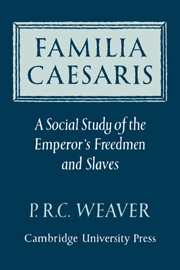PART II - THE FAMILY CIRCLE
Published online by Cambridge University Press: 07 October 2011
Summary
In Roman society of all periods the nuclear family constituted the basic social unit whether in freeborn, freed or slave society, whether the members were citizen or non-citizen. We are not here concerned with familia in the sense of household or that slave–freedman unit under the control of the paterfamilias. It is evident that in the exercise of his potestas the dominus had originally a complete authority over his own slave household that could have profound effects on the intimate family life of his own slaves and freedmen. He could break up these units by selling children to other masters, forbid marriages with slaves of other masters, and in general act out his absolute legal powers to the point of inflicting the death penalty. But there came increasing legal restraints on arbitrary conduct by masters, and also an increasing obligation on the part of the master, in his own economic self-interest, to conform to the domestic law of his own familia. This meant the recognition of his slave's right to his peculium or savings, with the primary purpose of buying his manumission, and no doubt the recognition of the existence of family ties as well among his slave family units, including their marriages and children. The fact that so many slaves themselves were owners of slaves would help to give a humanitarian balance to the way the system worked. These aspects as they concern the Familia Caesaris have been discussed in the Introduction.
- Type
- Chapter
- Information
- Familia CaesarisA Social Study of the Emperor's Freedmen and Slaves, pp. 93 - 96Publisher: Cambridge University PressPrint publication year: 1972



